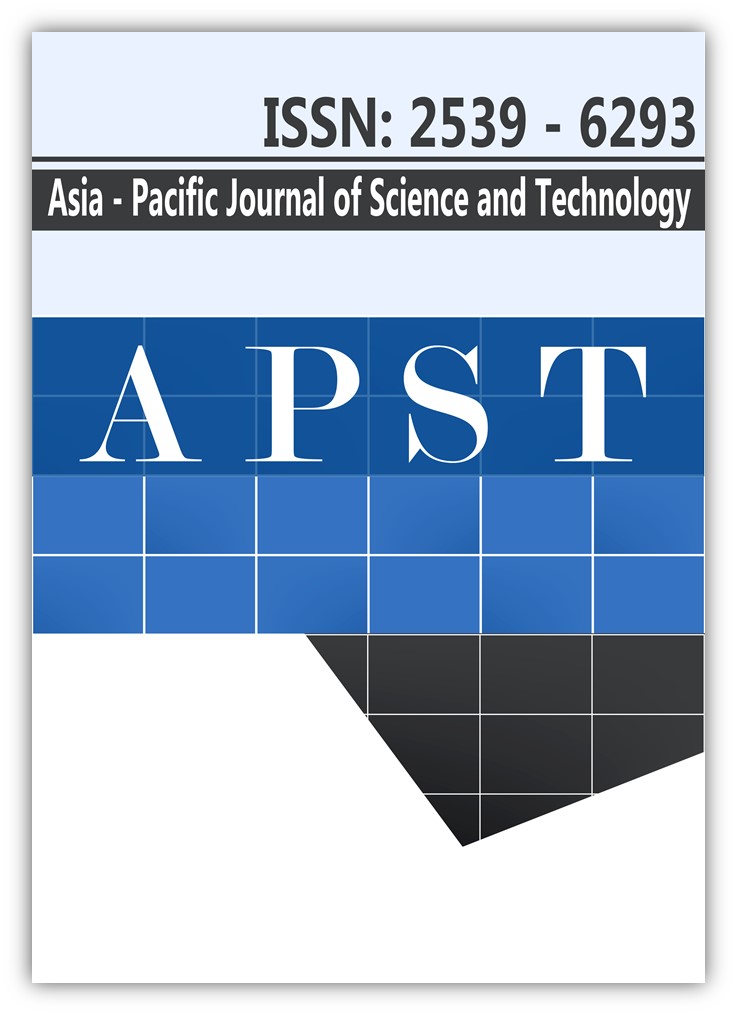Identification and characterization of membrane receptor protein YueB in Bacillus subtilis isolated from Thua Nao (Thai fermented soybean)
Main Article Content
Abstract
Thua nao (Thai fermented soybean) is a conventional and spontaneously fermented soybean in northern Thailand. The fermentation process relies on certain microbial activities, especially the Bacillus species. Bacteriophage contamination on Thua nao can rapidly decrease the Bacillus growth and the quality of any related products. The bacteriophage infection occurred through the YueB membrane receptor protein (coded by yueB gene) on the bacterial surface. Twenty isolates including Bacillus spp. were isolated from Thua nao. Phylogenetic analysis of Bacillus was determined using 16S-23S rRNAs nucleotide sequencing and compared with those obtained from the GenBank® database. Twenty Bacillus spp. isolated were classified into six clusters, which included Bacillus amyloliquefaciens, B. aryabhattai, B. cereus, B. licheniformis, B. sonorensis, B. subtilis and B. vallismortis. B. subtilis isolate TM4, TM5, TK7 and MR4 were selected to determine the variation of nucleotide sequences of yueB gene. Approximately 3.2 kb of yueB gene were amplified by Polymerase chain reaction (PCR) and directly sequencing. The translation of proteins retrieved 1,059 amino acid residues in all the isolate strains. The similarity alignment protein sequence of B. subtilis 168 as a reference strain revealed maximum identity scores of 81% and 1% of the gaps on the protein BLASTX alignment tools. The secondary structure of YueB protein indicated that the six transmembrane domain regions at one N-terminal and five C-terminal from B. subtilis isolate MR4, TK7, TM4 and TM5 were similar to that of B. subtilis 168. At the position between 200 to 600 amino acid residues, four regions were folded as coiled coil structures.
Article Details
References
[2] Chukeatirote E, Thakang P. Chemical composition of Thua nao˗A fermented soybean food of northern Thailand. Chiang Mai J Sci. 2006;33(2):243-245.
[3] Chukeatirote E, Dajanta K, Apichartsrangkoon A. Thua nao, indigenous Thai fermented soybean: A review. J Biol Sci. 2010;10(6):581-583.
[4] Inatsu Y, Kimura K, Itoh Y. Characterization of Bacillus subtilis strains isolated from fermented soybean foods in Southeast Asia: comparison with B. subtilis (natto) starter strains. Jpn Agric Res Q. 2002;36(3):169-175.
[5] Suppadit T, Sangla L, Pintasean S. A study on production processes and quality of fermented soybean (Thua-nao) in the upper north of Thailand. J Environ Manage. 2008;4(2):29-37.
[6] Chantawannakul P, Oncharoen A, Klanbut K, Chukeatirote E, Lumyoung S. Characterization of proteases of Bacillus subtilis strain 38 isolated from traditionally fermented soybean in northern Thailand. ScienceAsia. 2002;28(3):241-245.
[7] Dajanta K, Chukeatirote E, Apichartsrangkoon A. Nutritional and physicochemical qualities of Thua nao (Thai traditional fermented soybean). Chiang Mai J Sci. 2012;39(4):562-574.
[8] Kubo Y, Sriyam S, Nakagawa R, Kimura K. A survey of phage contamination in natto-producing factories and development of phage-resistant Bacillus subtilis (natto) strains. Food Sci Technol Res. 2018;24:485-492.
[9] Nagai T. Bacteriophages of Bacillus subtilis (natto) and their contamination in natto factories in Bacteriophage. In Kurtboke I, editor. Croatia; 2012. p. 95-110.
[10] Jakutytė L, Lurz R, Baptista C, Carballido-Lopez R, São-José C, Tavares P, Daugelavičius R. First steps of bacteriophage SPP1 entry into Bacillus subtilis. Arch Virol. 2012;422:425-434.
[11] São-José C, Baptista C, Santos MA. Bacillus subtilis operon encoding a membrane receptor for bacteriophage SPP1. J Bacteriol. 2004;186(24):8337-8346.
[12] Vinga I, Dröge A, Stiege AC, Lurz R, Santos MA, Daugelavičius R, Tavares P. The minor capsid protein gp7 of bacteriophage SPP1 is required for efficient infection of Bacillus subtilis. Mol Microbiol. 2006;61(6):1609-1621.
[13] Mamiatis T, Fritsch ET, Sambrook J. Molecular cloning: a laboratory manual. New York: Cold Spring Harbor Laboratory.; 1982. p. 61-67.
[14] Yamada Y, Katsura K, Kawasaki H, Widyastuti Y, Saono S, Seki T, Ucjimura T, Komagata K. Asaia bogorensis gen. nov., sp. nov., an unusual acetic acid bacterium in the α-Proteobacteria. Int J Syst Evol Microbiol. 2000;50:823-829.
[15] Zhang Y, Arias CR. Identification and characterization of an intervening sequence within the 23S ribosomal RNA genes of Edwardsiella ictalurid. Syst Appl Microbiol. 2007;30(2):93-101.
[16] Van camp G, Chappelle S, Wachter RD. Amplification and sequencing of variable region in bacteria 23S ribosomal RNA genes with conserved primer sequences. Curr Microbiol. 1993;27(3):147-151.
[17] Thompson JD, Higgins DG, Gibson TJ. CLUSTAL W: improving the sensitivity of progressive multiple sequence alignment through sequence weighting, position-specific gap penalties and weight matrix choice. Nucleic Acids Res. 1994;22(22):4673-4680.
[18] Bavykin SG, Lysov YP, Zakhariev V, Kelly JJ, Jackman J, Stahl DA., Cherni A. Use of 16S rRNA, 23S rRNA, and gyrB gene sequence analysis to determine phylogenetic relationships of Bacillus cereus group microorganisms. J Clin Microbiol. 2004;42(8):3711-3730.
[19] Wang LT, Lee FL, Tai CJ, Kasai H. Comparison of gyrB gene sequences, 16S rRNA gene sequences and DNA-DNA hybridization in the Bacillus subtilis group. Int J Syst Evol Microbiol. 2007;57(Pt8):1846-1850.
[20] Leejeerajumnean A. Thua nao: alkali fermented soybean from Bacillus subtilis. Silpakorn Univ Int J. 2003;3:277-292.


